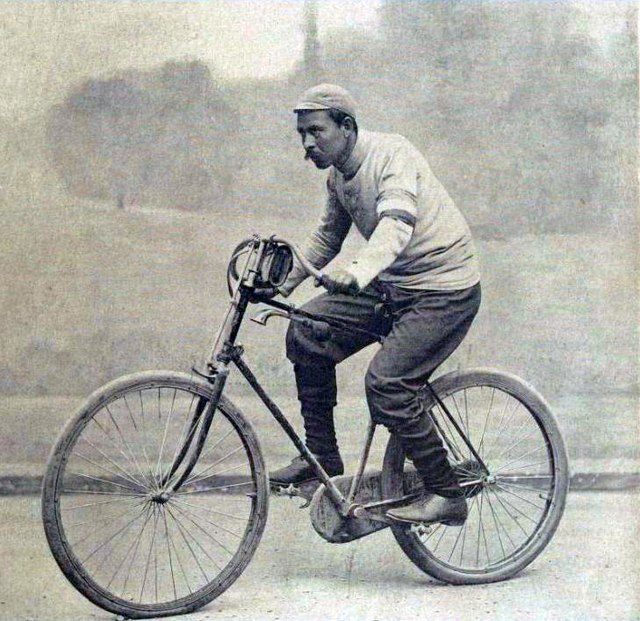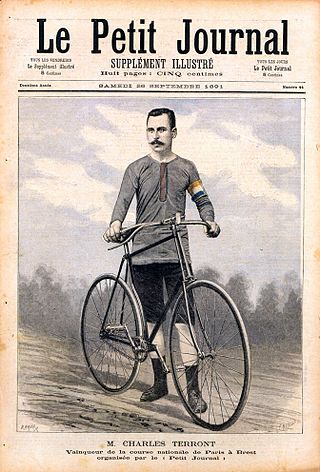Charles Terront
French cyclist (1857–1932) From Wikipedia, the free encyclopedia
Charles Terront (9 April 1857 – 31 October 1932) was the first major French cycling star. He won sprint, middle distance and endurance events in Europe and the United States. In September 1891 he won the first Paris–Brest–Paris cycle race, which at 1,196 kilometres (743 mi) was more than double the length of any previous event. He rode a Humber bicycle fitted with prototype removable pneumatic tyres made by Michelin.[1][2][3] He won 54 major events over his 15-year career, was Champion of France twice and Champion of Great Britain twice.
Charles Terront | |
|---|---|
 Terront on the front page of "Le Petit Journal" | |
| Born | 25 April 1857 Saint-Ouen, Seine-Saint-Denis, France |
| Died | 31 October 1932 (aged 75) |
| Nationality | French |

Early life and career
Terront was born in Saint-Ouen, Seine-Saint-Denis. He took up cycle racing in 1876 along with his brother Jules. Charles excelled at both endurance and speed events, and also won many events on a tandem with Jules.[2] He won 54 major solo events over his 15-year career, including being Champion of France twice and Champion of Great Britain twice.[3]
In 1879 Terront covered 546.327 kilometres (339 mi) in 24 hours.[2][4][dubious – discuss] On 27 September 1893 he left Saint Petersburg in Russia to cycle 3,000 kilometres (1,864 mi) across Poland and Germany, arriving at the Vélodrome Buffalo in Paris after 14 days and 7 hours.[2] In 1894 he completed a ride from Rome, Italy, to Paris.[2]
Paris–Brest–Paris cycle race
Summarize
Perspective

Pierre Giffard of Le Petit Journal created the Paris-Brest et retour cycle race in September 1891, describing it as an "épreuve", a test of the bicycle's reliability and the rider's endurance. Riders were fully self-sufficient, carrying their own food and clothing, and riding the same bicycle for the duration. The response was so phenomenal that riders were charged 5 francs to enter, and 300 riders signed up. Each bicycle was given an 'official seal' at a 2-day ceremony; the 280 sealed machines included 10 tricycles, 2 Tandem bicycles, and 1 Penny-farthing. Participation was restricted to French men (7 women were refused entrance), and 99 of the 207 (or 280[5]) participants finished.
Charles Terront won the event, covering the 1,196 kilometres (743 mi) in 71 hours 22 minutes, riding a Humber bicycle from the Beeston works in England. The bicycle weighed 21.5 kilograms and was equipped with Michelin's prototype pneumatic tyres (which were patented in 1891), front brake, curved handlebars, and a chain guard.[2] He passed his main rival Jiel-Laval from Adolphe Clément's Dunlop Clément team, after his manager, H.O. Duncan, advised him to take a detour around the town where his rival was sleeping during the third night. Both had suffered punctures in their pneumatic tyres, but still enjoyed an advantage over riders on solid tires. Terront's arrival in Paris was watched by a crowd of 10,000 people, many of whom had waited throughout the night.[2][6]
I pushed as hard as I could! The crowd was going delirious and closed in behind me, running as soon as I passed them, until I crossed the line. They tried to lift me off my bike, but I was able to alight on my own. Charles Terront.[2]
Honours
On account of Terront's fame, he was the first athlete to have his memoirs published during his lifetime. In 1893, he explained his life, races, and training methods to French journalist Louis Baudry de Saunier. Also in 1893 En suivant Terront by Herbert Duncan and Pierre Lafitte used 100 drawings to track his ride to Paris from Saint Petersburg.[2]
A plaque in Brest commemorates his 1891 victory in the Paris–Brest–Paris.[2]
The Rue Charles Terront in Nantes is named in his honour.
Major results by year
Summarize
Perspective
- 1876
- 1st - Paris-Pontoise-Paris
- 1st - Adamville
- 1st - Neuilly sur Seine
- 1st - Créteil
- 1st - Rouen
- 1st - Parc de Saint-Maur
- 1st - Saint-Germain
- 1st - Angers
- 1877
- 1st - Montauban
- 1st - Angers
- 1st - Saint-Ouen
- 1st - La Garenne-Colombes
- 1st - Charenton-le-Pont
- 1st - Saint-Denis
- 1st - ex-aequeo de Paris-Conflans-Sainte-Honorine
- 1878
- 1st - Boulogne-Versailles
- 1st - Argenteuil
- 1st - Adamville
- 1st - Maison-Blanche
- 1st - Rueil
- 1st - Saint-Denis
- 1st - Carrousel (Paris)
- 1st - Pré Catalan
- 1st - Courbevoie
- 1st - Versailles
- 1st - Point du Jour
- 1st - La Garenne-Colombes
- 1st - Fougères
- 1879
- 1st - Angers-Le Mans-Angers
- 1st - Angers
- 1st - Versailles
- 1st - Chaville
- 1st - Boulogne-Billancourt-Versailles-Boulogne Billancourt
- 1st - Carrousel (Paris)
- 1st - 6 days of Boston
- 1st - 6 days of Chicago
- 1880
- 1st - 6 days of London
- 1st - 6 days of Edinburgh
- 1st - 6 days of Kingston upon Hull
- 1st - Fougères
- 1st - Saint Denis
- 1st - Paris
- 1882
- 1st - Agen
- 1st - 6 hours of Angers
- 3rd Speed Championships of France
- 1883
- 1st - Fougères
- 2nd - Speed Championships of France
- 1884
- 1st - Fougères
- 1885
- 3rd - Speed Championships of France
- 1886
- 2nd - Speed Championships of France
- 3rd Middle distance Championships of France
- 1887
- 1st - 100 mile Championship of Great Britain
- Rennes
- 2nd Middle distance Championships of France
- 1888
- 1st - Middle distance Championships of France
- 1st - 10 mile Championship of Great Britain
- 1889
- 1st - Middle distance Championships of France
- 1891
- 1st - Paris–Brest–Paris
See also
- James Moore (cyclist) - winner of 'first' cycle races in 1868 in Paris and 1869 Paris–Rouen
- Paris–Rouen - first 'city to city' cycle race (1869)
- Bordeaux–Paris - first long-distance cycle race (May 1891)
- George Pilkington Mills - winner of Bordeaux–Paris cycle race
References
Bibliography
External links
Wikiwand - on
Seamless Wikipedia browsing. On steroids.
